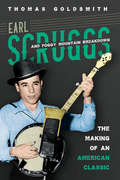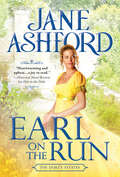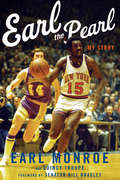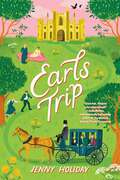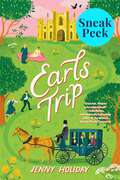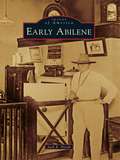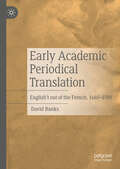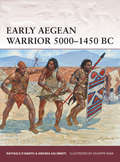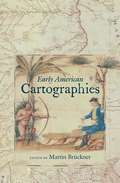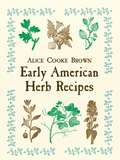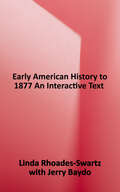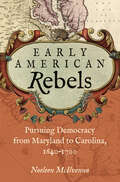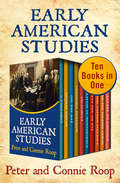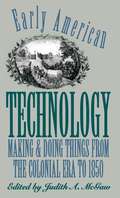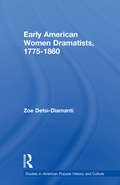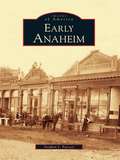- Table View
- List View
Earl Scruggs and Foggy Mountain Breakdown: The Making of an American Classic (Music in American Life #476)
by Thomas GoldsmithRecorded in 1949, "Foggy Mountain Breakdown" changed the face of American music. Earl Scruggs's instrumental essentially transformed the folk culture that came before it while helping to energize bluegrass's entry into the mainstream in the 1960s. The song has become a gateway to bluegrass for musicians and fans alike as well as a happily inescapable track in film and television.Thomas Goldsmith explores the origins and influence of "Foggy Mountain Breakdown" against the backdrop of Scruggs's legendary career. Interviews with Scruggs, his wife Louise, disciple Bela Fleck, and sidemen like Curly Seckler, Mac Wiseman, and Jerry Douglas shed light on topics like Scruggs's musical evolution and his working relationship with Bill Monroe. As Goldsmith shows, the captivating sound of "Foggy Mountain Breakdown" helped bring back the banjo from obscurity and distinguished the low-key Scruggs as a principal figure in American acoustic music.Passionate and long overdue, Earl Scruggs and Foggy Mountain Breakdown takes readers on an ear-opening journey into two minutes and forty-three seconds of heaven.
Earl on the Run (The Duke's Estates #2)
by Jane AshfordFans of Mary Balogh, Ella Quinn, and Bridgerton will fall in love with the charismatic characters and glittering detail of Jane Ashford's bestselling Regency romances:A reluctant earl flees from his new roleA willful lady yearns to escape her family's strict rulesThey may find refuge in each otherThe missing Earl of Ferrington doesn't want to be found…At the end of the London season, Harriet Finch reluctantly returns to her wealthy grandfather's country house. His rigid opinions for how she should live and whom she should marry sparks Harriet's rebelliousness. Yearning to reclaim her freedom, Harriet goes for a long walk and a handsome rogue from the nearby Travelers camp catches her eye.Little does she know, the rugged Traveler she's flirting with is the missing Earl of Ferrington in disguise. Will this intriguing man, who goes by "Jack" tell Harriet the truth about who he is for the sake their blossoming relationship? Or will he keep his distance altogether? Time is running out, and the earl can't hide forever…"Impossible to put down… The story crackles with clever dialogue and humorous scenes." —Historical Novel Society for The Duke Who Loved Me"An irresistibly sweet literary confection." —Booklist for Earl to the Rescue"Complex characters, subtle romance, and all the sparkling wit and flirtatious banter of a Georgette Heyer novel." —Publishers Weekly for A Duke Too Far
Earl the Pearl: My Story
by Quincy Troupe Earl MonroeEarl "The Pearl" Monroe is a basketball legend whose impact on the game transcends statistics, a player known as much for his unorthodox, "playground" style of play as his championship pedigree. Observers said that watching him play was like listening to jazz, his moves resembling freefloating improvisations. "I don't know what I'm going to do with the ball," Monroe once admitted, "and if I don't know, I'm quite sure the guy guarding me doesn't know either."Traded to the New York Knicks before the 1971–72 season, Monroe became a key member of the beloved, star-studded 1972–73 Knicks team that captured the NBA title. And now, on the 40th anniversary of that championship season—the franchise's last—Monroe is finally ready to tell his remarkable story.Written with bestselling author Quincy Troupe (Miles, The Pursuit of Happyness) Earl the Pearl will retrace Monroe's life from his upbringing in a tough South Philadelphia neighborhood through his record-setting days at Winston-Salem State, to his NBA Rookie of the Year season in 1967, his tremendous years with the Baltimore Bullets and ultimately his redemptive, championship glory with the New York Knicks. The book will culminate with a revealing epilogue in which Monroe reflects on the events of the past 40 years, offers his insights into the NBA today, and his thoughts on the future of the game he loves.
Earl to the Rescue
by Jane AshfordWho needs a knight in shining armor when there's an earl at your side...?Gwendeline Gregory doesn't know what to think when she encounters the dashing Alex St. Audley, Earl of Merryn. She's in over her head in London Society, trying to fend off a scoundrel who will stop at nothing to ruin her. On the brink of a devastating scandal, the earl arrives just when she needs him most. But are his motivations trustworthy? And can he avert ruin for both of them?What People Are Saying About Jane Ashford: "Jane Ashford absolutely delights."—Night Owl Reviews "Exquisite...one to savor."—Library Journal for The Duke Knows Best "Filled with wit and charm."—Fresh Fiction for Nothing Like a Duke"Expertly crafted...another triumph of nuanced characterization and sparkling wit."—Booklist for Nothing Like a Duke
Earl's Well That Ends Well (The Way to a Lord's Heart #5)
by Jane AshfordThis beautiful, clean Regency romance from beloved author Jane Ashford takes you to a glittering world of revelations and romance, where a lonely earl can find love where he least expects it...Arthur Shelton, Earl of Macklin, has helped four young noblemen recover from grief and find love, but he's learned to live his own life as a widower. Yet when he returns home after traveling, his estate feels too empty, and he quickly heads to London. There, he encounters Teresa Alvarez de Granada, a charming Spanish noblewoman and is immediately entranced.There is no room for earls in the quiet, safe life Teresa has finally found for herself. The earl might be charming and handsome, but she knows firsthand how dangerous attraction can be. The more determined Teresa is to discourage Arthur, the more entangled they get, and it's only a matter of time before her respect for him starts to feel a lot like love.Praise for Jane Ashford's Regency romances:"Humor, drama, mystery, romance, intrigue, and a surprising ending."—Harlequin Junkie for How to Cross a Marquess"An irresistible love story."—Library Journal for A Duke Too Far"Expertly crafted...another triumph of nuanced characterization and sparkling wit."—Booklist for Nothing Like a Duke
Earls Colne's Early Modern Landscapes
by Dolly MacKinnonThe Essex village of Earls Colne boasts one of the most comprehensive collections of historical documents in Britain, and has been the subject of an intensive and ongoing research project to collate and computerise the surviving records. As such, Earls Colne is undoubtedly one of the most studied parishes in England. Yet whilst much is now known about the village and its inhabitants, little work has been done on the social relationships that bound the community together within its mental and physical landscape. As such, scholars will welcome Dr MacKinnon’s investigation into the social, political and cultural world of early modern England as represented by Earls Colne. The book provides a fresh approach to the study of the landscape of a seventeenth-century village by focussing on the relationships between political power and cultural artefacts. It examines how private, public and communal spaces within society were generated, gendered and governed, and how this was recorded and perpetuated in the records, names, and monuments of the parish and surrounding landscape. Yet whilst the ’elites’ tried to represent a select social landscape through their control of the local records and documents, these attempts were always counterbalanced by the less powerful members of the community who occupied and contested these spaces. By reconstructing the dynamics of Earls Colne through a careful reading and cross-referencing of the surviving documents, buildings and place names, this book offers a fascinating insight into how the sights and sounds of early modern society were imbued with the social relations of parish politics. As well as deepening our understanding of Earls Colne itself, the book offers historians the potential to revisit other local studies from a fresh perspective.
Earls Just Want to Have Fun
by Shana GalenHis heart may be the last thing she ever steals...Marlowe is a pickpocket, a housebreaker-and a better actress than any professional on the stage. She runs with the Covent Garden Cubs, a gang of thieves living in the slums of London's Seven Dials. It's a fierce life, and Marlowe has a hard outer shell. But when she's alone, she allows herself to think of a time before-a dimly remembered life when she was called Elizabeth.Maxwell, Lord Dane, is intrigued when his brother, a hired investigator, ropes him into his investigation of the fiercely beautiful hellion. He teaches her to navigate the social morass of the ton, but Marlowe will not escape so easily. Instead, Dane is drawn into her dangerous world, where the student becomes the teacher and love is the greatest risk of all.Praise for If You Give a Rake a Ruby: "A gem of a read...Galen is at the top of her game." -RT Book Reviews, 4 stars, Top Pick of the Month "Brilliant historical romance! A lovely read that I absolutely adored." -Imagine a World "Remarkable characters...and love that shimmers and shines." -Long and Short Reviews "Captivating...Ms. Galen delivers a steamy romance." -Night Owl Reviews, Reviewer Top Pick, 5 stars
Earls Trip (Earls Trip #1)
by Jenny HolidayAS SEEN ON THE TODAY SHOW!"This is a witty, charming, character-driven story that is honestly one of the best historical romances I&’ve read in years." —Julia Quinn, bestselling author of the Bridgerton novels on the TODAY ShowTed Lasso meets Bridgerton for a 19th century spin on The Hangover in USA Today bestselling author Jenny Holiday&’s laugh-out-loud bromantic comedy featuring three Regency-era Earls on their annual trip – ride-or-die buddies offering one another unconditional support in everything from Lady problems to family woes.From the author of CANADIAN BOYFRIEND, the perfect romp for fans of Evie Dunmore, India Holton, Virginia Heath, Manda Collins, and Suzanne Allain! Even an earl needs his ride-or-dies, and Archibald Fielding-Burton, the Earl of Harcourt, counts himself lucky to have two. The annual trip that Archie takes with his BFFs Simon and Effie holds a sacred spot in their calendars. This year Archie is especially eager to get away until an urgent letter arrives from an old family friend, begging him to help prevent a ruinous scandal. Suddenly the trip has become earls-plus-girls, as Archie&’s childhood pals, Clementine and Olive Morgan, are rescued en route to Gretna Green. This…complicates matters. The fully grown Clementine, while as frank and refreshing as he remembers, is also different to the wild, windswept girl he knew. This Clem is complex and surprising—and adamantly opposed to marriage. Which, for reasons Archie dare not examine too closely, he finds increasingly vexing. Then Clem makes him an indecent and quite delightful proposal, asking him to show her the pleasures of the marriage bed before she settles into spinsterhood. And what kind of gentleman would he be to refuse a lady?
Earls Trip: Sneak Peek (Earls Trip)
by Jenny HolidayBe one of the first to read this sneak preview sample edition!Ted Lasso meets Bridgerton for a 19th century spin on The Hangover in USA Today bestselling author Jenny Holiday&’s laugh-out-loud bromantic comedy featuring three Regency-era Earls on their annual trip—ride-or-die buddies offering one another unconditional support in everything from Lady problems to family woes.Even an earl needs his ride-or-dies, and Archibald Fielding-Burton, the Earl of Harcourt, counts himself lucky to have two. The annual trip that Archie takes with his BFFs Simon and Effie holds a sacred spot in their calendars. This year Archie is especially eager to get away until an urgent letter arrives from an old family friend, begging him to help prevent a ruinous scandal. Suddenly the trip has become earls-plus-girls, as Archie&’s childhood pals, Clementine and Olive Morgan, are rescued en route to Gretna Green.This…complicates matters. The fully grown Clementine, while as frank and refreshing as he remembers, is also different to the wild, windswept girl he knew. This Clem is complex and surprising—and adamantly opposed to marriage. Which, for reasons Archie dare not examine too closely, he finds increasingly vexing.Then Clem makes him an indecent and quite delightful proposal, asking him to show her the pleasures of the marriage bed before she settles into spinsterhood. And what kind of gentleman would he be to refuse a lady?
Early Abilene
by Jack E. NorthDuring the 1870s, there was wondrous change in West Texas. The area was ripe for settlement, and as the Texas and Pacific Railroad pushed west from Fort Worth, towns began springing up along the tracks. Ranchers coming to the area took advantage of the vast grasslands, and the new arrival of settlers was the beginning of a town named Abilene. Deriving its namesake from the town of Abilene, Kansas, the locals hoped the city would become a shipping point for cattle on their way to eastern markets. The town has since grown to be one of West Texas's most thriving metropolitan areas. The city--which is home to Dyess Air Force Base--is also well known for its numerous parks, schools, universities, and historic neighborhoods that are enjoyed by its 120,000 residents.
Early Academic Periodical Translation: English't out of the French, 1665-1700
by David BanksThis book looks at the translations which appeared in the Philosophical Transactions and whose source texts had appeared in the Journal des Sçavans during the period 1665 to 1700. The theoretical background of the study is Systemic Functional Linguistics. The book provides linguistic analyses of both translations and source texts, considering in particular process types, the nature of themes, modality and nominalization of processes. The periods looked at are defined in terms of the editors of the respective journals. Differences in the linguistic features of the translations and source texts are explained in terms of the historical context. Since these were the first two academic periodicals, the texts studied here were the first attempts at translating academic articles, and thus have particular significance.
Early Aegean Warrior 5000-1450 BC
by Giuseppe Rava Raffaele D'AmatoThe civilisations of the Greece in the Ancient World have inspired and fascinated throughout European history. The stories of Homer, later reinforced by the pioneering archaeological work carried out by men such as Heinrich Schliemann at Mycenae and Sir Arthur Evans at Knossos, have enabled modern researchers and historians to piece together a rich material culture and reconstruct the mysteries of the Ancient World.The mainland and islands of Greece were extensively settled by peoples moving from Asia Minor in c.5000 BC, while a further wave in c.5000 BC introduced bronze-working to the region. It is form this point on that it is possible to discern a distinct Cycladic or Aegean civilisation, developing at roughly the same time as the Egyptian and Persian civilisations. Further to the south, the Minoan civilisation based on Crete held sway, and this power - along with the Helladic Achaeans to the north gradually swamped the Cycladic civilisation in between.In common with most Bronze Age societies, the culture of the Aegean world was dominated by warfare, with the inhabitants living in organized settlements and small citadels with fortification walls and bulwarks, towers and gates to provide protection against invaders from the sea or internecine conflicts. Using the latest archaeological evidence, this title recreates the world of these peoples through a detailed examination of their material culture.
Early American Cartographies
by Martin BrücknerMaps were at the heart of cultural life in the Americas from before colonization to the formation of modern nation-states. The fourteen essays in Early American Cartographies examine indigenous and European peoples' creation and use of maps to better represent and understand the world they inhabited. Drawing from both current historical interpretations and new interdisciplinary perspectives, this collection provides diverse approaches to understanding the multilayered exchanges that went into creating cartographic knowledge in and about the Americas. In the introduction, editor Martin Bruckner provides a critical assessment of the concept of cartography and of the historiography of maps. The individual essays, then, range widely over space and place, from the imperial reach of Iberian and British cartography to indigenous conceptualizations, including "dirty," ephemeral maps and star charts, to demonstrate that pre-nineteenth-century American cartography was at once a multiform and multicultural affair. This volume not only highlights the collaborative genesis of cartographic knowledge about the early Americas; the essays also bring to light original archives and innovative methodologies for investigating spatial relations among peoples in the western hemisphere. Taken together, the authors reveal the roles of early American cartographies in shaping popular notions of national space, informing visual perception, animating literary imagination, and structuring the political history of Anglo- and Ibero-America.The contributors are: Martin Bruckner, University of Delaware Michael J. Drexler, Bucknell UniversityMatthew H. Edney, University of Southern MaineJess Edwards, Manchester Metropolitan UniversityJunia Ferreira Furtado, Universidade Federal de Minas Gerais, BrazilWilliam Gustav Gartner, University of Wisconsin-MadisonGavin Hollis, Hunter College of the City University of New YorkScott Lehman, independent scholarKen MacMillan, University of CalgaryBarbara E. Mundy, Fordham UniversityAndrew Newman, Stony Brook UniversityRicardo Padron, University of VirginiaJudith Ridner, Mississippi State University
Early American Children’s Clothing and Textiles: Clothing a Child 1600-1800
by Carey Blackerby HansonEarly American Children’s Clothing and Textiles: Clothing a Child 1600–1800 explores the life experiences of Indigenous, Anglo-European, African, and mixed-race children in colonial America, their connections to textile production, the process of textile production, the textiles created, and the clothing they wore. The book examines the communities and social structure of early America, the progression of the colonial textile industry, and the politics surrounding textile production beginning in the 1600's, with particular focus on the tasks children were given in the development of the American textile industry. The book discusses the concept of childhood in society during this time, together with documented stories of individual children. The discussion of early American childhood and textile production is followed by extant clothing samples for both boys and girls, ranging from Upper-class children's wear to children's wear of those with more humble means. With over 180 illustrations, the book includes images of textile production tools, inventions, and practices, extant textile samples, period portraits of children, and handmade extant clothing items worn by children during this time period. Early American Children’s Clothing and Textiles: Clothing a Child 1600–1800 will be of interest to working costume designers and technicians looking for primary historical and visual information for Early American productions, costume design historians, early American historians, students of costume design, and historical re-enactment costume designers, technicians, and hobbyists.
Early American Drama
by Various Jeffrey H. RichardsThis unique volume includes eight early dramas that mirror American literary, social, and cultural history: Royall Tylers The Contrast (1789); William Dunlap'sAndre (1798); James Nelson Barker's The Indian Princess (1808); Robert Montgomery Bird's The Gladiator (1831); William Henry Smith's The Drunkard(1844); Anna Cora Mowatt's Fashion (1845); George Aiken's Uncle Tom's Cabin(1852); and Dion Boucicault's The Octoroon (1859).
Early American Herb Recipes
by Alice Cooke BrownFor early American households, the herb garden was an all-purpose medicine chest. Herbs were used to treat apoplexy (lily of the valley), asthma (burdock, horehound), boils (onion), tuberculosis (chickweed, coltsfoot), palpitations (saffron, valerian), jaundice (speedwell, nettles, toad flax), toothache (dittander), hemorrhage (yarrow), hypochondria (mustard, viper grass), wrinkles (cowslip juice), cancers (bean-leaf juice), and various other ailments. But herbs were used for a host of other purposes as well -- and in this fascinating book, readers will find a wealth of information on the uses of herbs by homemakers of the past, including more than 500 authentic recipes, given exactly as they appeared in their original sources.Selected from such early American cookbook classics as Miss Leslie's Directions for Cookery, Mary Randolph's The Virginia Housewife, Lydia Child's The American Frugal Housewife, and other rare publications, the recipes cover the use of herbs for medicinal, culinary, cosmetic, and other purposes. Readers will discover not only how herbs were used in making vegetable and meat dishes, gravies and sauces, cakes, pies, soups, and beverages, but also how our ancestors employed them in making dyes, furniture polish, insecticides, spot removers, perfumes, hair tonics, soaps, tooth powders, and numerous other products. While some formulas are completely fantastic, others (such as a sunburn ointment made from hog's lard and elder flowers) were based on long experience and produced excellent results.More than 100 fine nineteenth-century engravings of herbs add to the charm of this enchanting volume -- an invaluable reference and guide for plant lovers and herb enthusiasts that will "delight and astound the twentieth-century reader." (Library Journal).
Early American History To 1877: An Interactive Text
by Linda Rhoades-SwartzThe thirteen chapters of the book, Early American History to 1877 An Interactive Text include, Native Americans and Exploration, Colonial Settlement and Colonial Slavery, Life in Colonial America, The French and Indian War: Prelude to Revolution, The American Revolution, Creating a Nation, Our First Leaders: Washington and Adams, New Century for an Emerging Power: Jefferson to John Quincy Adams, The Rise of a National Culture, The Age of Jackson and the Rise of the Whig Party, The Era of Manifest Destiny: Tyler to Fillmore, The Coming of the Civil War, The Civil War and Reconstruction. Every chapter has its summary and to know more details, all the chapters contain an Introduction, Essay, Suggested Readings, Suggested Websites, and Questions to Ponder.
Early American Houses: With A Glossary of Colonial Architectural Terms
by Norman Morrison IshamAn intriguing examination of classic colonial houses, this fact-filled foray explores with remarkable concision the "medieval period" of American architecture. The treatise takes for its examples the first houses built along the Atlantic coast in the seventeenth century. While these early structures were usually based on traditional English and Dutch styles, their design and methods of construction soon acquired a unique character of their own. Geographically remote from the stylistic restrictions of Europe, American architects used new plans and construction elements to create fresh new dwellings with individual beauty and charm. Early American Houses includes over 100 photographs and illustrations that highlight the architecture of young America, with a particular focus on the Tudor and late Gothic styles that ultimately shaped the distinctive house designs of today. Original floor plans and sketches abound -- including interior and exterior treatments, elevations, and framing -- partnered with detailed descriptions that breathe life into each construction. Accompanying this work is a comprehensive Glossary of Colonial Architectural Terms. Originally published separately, it provides definitions for everything from "arch" to "wainscot," and it is reprinted here to enhance the overall value of the companion volume.
Early American Rebels: Pursuing Democracy from Maryland to Carolina, 1640–1700
by Noeleen McIlvennaDuring the half century after 1650 that saw the gradual imposition of a slave society in England's North American colonies, poor white settlers in the Chesapeake sought a republic of equals. Demanding a say in their own destinies, rebels moved around the region looking for a place to build a democratic political system. This book crosses colonial boundaries to show how Ingle's Rebellion, Fendall's Rebellion, Bacon's Rebellion, Culpeper's Rebellion, Parson Waugh's Tumult, and the colonial Glorious Revolution were episodes in a single struggle because they were organized by one connected group of people. Adding land records and genealogical research to traditional sources, Noeleen McIlvenna challenges standard narratives that disdain poor whites or leave them out of the history of the colonial South. She makes the case that the women of these families played significant roles in every attempt to establish a more representative political system before 1700. McIlvenna integrates landless immigrants and small farmers into the history of the Chesapeake region and argues that these rebellious anti-authoritarians should be included in the pantheon of the nation's Founders.
Early American Steam Locomotives
by Reed KinertRelive the early days of train travel with this exciting illustrated story of steam locomotion. Working with great love and skill from builders' specifications, old engravings, and contemporaneous accounts, author Reed Kinert recreates, in exacting detail, illustrations of the earliest locomotives—many of which were built and used before the advent of photography.More than 100 illustrations, many in color, portray the venerable "iron horses"—from the tiny Tom Thumb (which, early in its career, lost a race to a horse-drawn wagon) to vertical "teakettles" and "grasshoppers," and the streamlined "titans," outfitted with bells, whistles, and lights. Railroading enthusiasts, model rail hobbyists, and Americana buffs will be delighted with this expert pictorial-guided tour through the early days of the "iron horse."
Early American Studies: Ten Books in One (Palgrave Studies In Theatre And Performance History #Vol. 21)
by Peter Roop Connie RoopAmerican history comes alive for young readers in this collection of richly detailed narratives ranging from Christopher Columbus to Abraham Lincoln. These “direct and surprisingly accessible” histories, often told in the actual words of key figures from the American past, are a brilliant blend of fact and imagination (Publishers Weekly). I, Columbus: A firsthand account of Christopher Columbus’s famous voyage to the East, taken directly from his journal entries. He tells of excitement, drama, and terror on the high seas, as he and his crew weather the path to discovery. Pilgrim Voices: The pilgrims’ own writings of their voyage on the Mayflower, their first encounters with indigenous people, and their Thanksgiving celebration after surviving a difficult first winter in the New World. Off the Map: The story of Lewis and Clark’s famous 1804 expedition into the uncharted lands of America, in an accessible version drawn from the explorers’ own account. Louisiana Purchase: Biographical sketches of Lewis and Clark, Napoleon Bonaparte, and Thomas Jefferson tell the story of the United States’ expansion into a new territory and a new era. Sacagawea: Told from Sacagawea’s point of view, this historical novel shares the ordeals of her youth along with the memory of her journey west with Lewis and Clark. She shares her love of nature and explains how her loyalties have changed over time. The Declaration of Independence: Covering major events such as the Boston Massacre and Paul Revere’s midnight ride, this accessible history brings the story of the Revolutionary War to life. An Eye for an Eye: When her brother is captured at the start of the Revolutionary War, fourteen-year-old Samantha sets off to rescue him. But when she comes face-to-face with the enemy, will she still stand by her peaceful principles? Take Command, Captain Farragut!: Ten-year-old David Glasgow Farragut is the youngest midshipman ever assigned to a warship in the US Navy. Told through fictional letters that Farragut writes from prison after his capture in the War of 1812, this richly imagined story is based on real history. Ahyoka and the Talking Leaves: Ahyoka’s father is a Cherokee silversmith who dreams of a written language for his people. When he is ostracized for the “magic” he is creating, father and daughter leave home to pursue his dream on their own. Grace’s Letter to Lincoln: After seeing Abraham Lincoln on a poster, eleven-year-old Grace decides to write to him and suggest that he might win more votes in the 1860 election if he grows a beard. Much to her surprise, Lincoln answers her letter, and history is made. This “touching historic encounter” is based on true events (Scholastic).
Early American Technology
by Judith A. McgawThis collection of original essays documents technology's centrality to the history of early America. Unlike much previous scholarship, this volume emphasizes the quotidian rather than the exceptional: the farm household seeking to preserve food or acquire tools, the surveyor balancing economic and technical considerations while laying out a turnpike, the woman of child-bearing age employing herbal contraceptives, and the neighbors of a polluted urban stream debating issues of property, odor, and health. These cases and others drawn from brewing, mining, farming, and woodworking enable the authors to address recent historiographic concerns, including the environmental aspects of technological change and the gendered nature of technical knowledge. Brooke Hindle's classic 1966 essay on early American technology is also reprinted, and his view of the field is reassessed. A bibliographical essay and summary of Hindle's bibliographic findings conclude the volume. The contributors are Judith A. McGaw, Robert C. Post, Susan E. Klepp, Michal McMahon, Patrick W. O'Bannon, Sarah F. McMahon, Donald C. Jackson, Robert B. Gordon, Carolyn C. Cooper, and Nina E. Lerman.
Early American Women Dramatists, 1780-1860 (Studies in American Popular History and Culture)
by Zoe Desti-DemantiFirst published in 1999. Although contemporary feminist criticism has mainly focused upon American women playwrights of the twentieth century-women, there is evidence that a feminist tradition rooted deep in the nationalistic and democratic impulses of the American nation existed more than a hundred years before these women started writing. It may come as a surprise to some readers that a significant but overlooked number of women playwrights vitally contributed to the development of early American drama. This study covers the period between 1775 and 1860, a time when American men and women struggled to define themselves and their place in response to the radical economic and institutional transformations which characterized that period. Based on the assumption that women's experience of the world differs from men's, the author tries to show that the plays of my study are sites of gender inscriptions as well as collective evidence that late-eighteenth and nineteenth-century men and women were affected differently by the economic, political, and social changes that were taking place in America at that time.
Early American Wooden Ware & Other Kitchen Utensils
by Mary Earle GouldAn authoritative and comprehensive history of wooden ware, including old New England kitchens, pantry tools, bowls, plates, mortars, buckets, tubs, the early uses of paint, means of identification, and much more.“It would be hard to say how and where the material for this book was gathered. From my childhood I have been interested in early manners, customs, and sayings, and have retained as I have learned. It was natural, then, that wherever I went as a collector I questioned and listened, and no chance remarks slipped by unheeded. A notebook went with me and I began to keep a diary of the happenings of the days….“With many happy memories of places I have visited, of acquaintances I have made, of hospitality shown me by those of an older generation and of interesting correspondence with all parts of the United States, I have written my book.“This enlarged edition has been made possible by more research work and by helpful correspondence from those interested in recording this early history. A few more pieces of wooden ware have come to the museum which now numbers over 1,000 pieces, including the iron fireplace utensils.”—Mary Earle Gould
Early Anaheim (Images of America)
by Stephen J. FaesselAs one of the largest cities in one of the nation's most populous counties, Anaheim anchors a host of Orange County attractions, not the least of which are Disneyland, the 2002 World Champion Anaheim Angels, and the Anaheim Convention Center. But Anaheim's early history followed the hardscrabble route, with fitful years of early cityhood steered in part by hardy immigrant German vintners who, with a civic-mindedness, advanced the establishment of the churches, schools, banks, civic services, and a Carnegie Library that made Anaheim thrive. This collection of more than 200 vintage images reveals the foresight of such men as John Frohling, Charles Kohler, George Hansen, John Fischer, August Langenberger, and others who shaped the beginnings of one of California's great cities.
